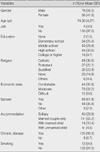Abstract
Purpose
This study was done to identify the factors which influence depression for elderly people who live at home.
Methods
The participants were 134 elderly people living at home in M city. Data were collected from April 2 to 30, 2009 and analyzed using SPSS/WIN 12.0 and AMOS 5.0 program. I assumed path coefficients by doing path analysis to understand synthetically causal relationship which influences on depression.
Results
Social support, sleep pattern and self esteem had significant direct effects on life satisfaction and accounted for 50% of the total variance in life satisfaction. Physical symptoms, sleep pattern and life satisfaction also had significant direct effects on depression and accounted for 59% of the variance in depression. But social support, self assertiveness and self esteem were not significant for depression.
Figures and Tables
References
1. Alexopoulos GS. Depression in the elderly. The Lancet. 2005. 365:1961–1970.
2. An JY, Tak YR. Depressive symptoms and related risk factors in old and oldest-old elderly people with arthritis. Journal of Korean Academy of Nursing. 2009. 39:72–83.
3. Beutel ME, Glaesmer H, Wiltink J, Marian H, Brahler E. Title Life satisfaction, anxiety, depression and resilience across the life span of men. Aging Male. 2010. 13:32–39.
4. Cho NO, Yang KR, Hong YS, Lee EO, Cheo MA. The relationship between family function and depression of elderly according to their assertiveness and pattern of interaction in expanded families. Seoul Journal of Nursing. 1998. 12:185–201.
5. Cho SB. Structural equation model. 1996. Seoul: Youngji Publishers.
6. Choi SJ. A study on the development of life satisfaction scale for elderly. Ewha Womans University Korean Culture Nonchong. 1986. 49:233–258.
7. Djernes JK. Prevalence and predictors of depression in populations of elderly. Acta Psychiatrica Scandinavica. 2006. 113:372–387.
8. Hair JF. Multivariate date analysis. 1979. Oklahoma: Petroleum Publishing Company.
9. Hwang HK. The effect of exercise program on depression, self-esteem, and life satisfaction of the elderly. 2007. Masan: Kyungnam University;Unpublished master's thesis.
10. Jeon BJ. Self-esteem: A test of its measurability. Yonsei Nonchong. 1974. 11:107–129.
11. Jung IK, Kwak DI, Joe SH, Lee HS. A study of standardization of Korean form of geriatric depression scale (KGDS). Journal of Korean Geriatric Psychiatry. 1997. 1:61–72.
12. Kaneko Y, Motohashi Y, Sasaki H, Yamaji M. Prevalence of depressive symptoms and related risk factors for depressive symptoms among elderly persons living in rural japanese community: A cross-sectional study. Community Mental Health Journal. 2007. 43:583–590.
13. Kim KB, Sok SH. Factors influencing depression of the elderly. Journal of Korean Academy of Community Health Nursing. 2009. 20:197–206.
14. Kim PK. A study on the relation between assertiveness and depression in the elderly. 1998. Seoul: Hanyang University;Unpublished master's thesis.
15. Korea National Statistical Office. Cause of death statistics. 2005. Seoul: Author.
16. Korea National Statistical Office. Statistics of aged. 2008. Seoul: Author.
17. Kroenke K, Spitzer RL, William JB. The PHQ-15: Validity of a new measure for evaluating the severity of somatic symtoms. Psychosomatic Medicine. 2002. 64:258–266.
18. Lee HS. Health status and utilization of long-term care facility in the urban and rural aged. Journal of Korean Academy of Community Health Nursing. 2008. 19:260–269.
19. Moon MJ. Analysis on the structural model of life satisfaction for elderly home residents. Journal of Korean Gerontological Nursing. 2004. 6:202–215.
20. Oh JJ, Song MS, Kim SM. Development and validation of korea sleep scale A. Journal of Korean Academy of Nursing. 1998. 28:563–572.
21. Park JW. A study to develop a scale of social support. 1985. Seoul: Yonsei University;Unpublished doctoral dissertation.
22. Rakos RF, Schroeder HE. Development and empirical evaluation of a self-administered assertiveness training program. Journal of Consulting and Clinical Psychology. 1979. 47:991–993.
23. Rosenberg M. Society and the adolescent self image. 1965. Princeton, NJ: Princeton University Press.
24. Segal DL. Relationships of assertiveness, depression, and social support among older nursing home residents. Behavior Modification. 2005. 29:689–695.
25. Seo HS, Han YH. Effects of health-related index on life satisfaction for the elderly people. Korean Journal of Research in Gerontology. 2006. 15:159–170.
26. Shin KR, Kang YH, Jung DY, Choi KA. A study on the depression, somatic symptom, activities of daily living for the elderly women in an urban area. Journal of Korean Academy of Nursing. 2007. 37:1131–1138.
27. Song MS. Construction of a functional status prediction model for the elderly. 1991. Seoul: Seoul National University;Unpublished doctoral dissertation.
28. Taft LB. Self-esteem in later life: A nursing perspective. Advanced Nursing Science. 1985. 8:77–84.
29. Tak YR, Kim SA, Lee BS. Perceived social support, instrumental support needs, and depression of elderly women. Korean Journal of Women Health Nursing. 2003. 9:449–456.
30. Yao KW, Yu S, Cheng SP, Chen IJ. Relationships between personal, depression and social network factors and sleep quality in community-dwelling older adults. Journal of Nursing Research. 2008. 16:131–138.




 PDF
PDF ePub
ePub Citation
Citation Print
Print








 XML Download
XML Download